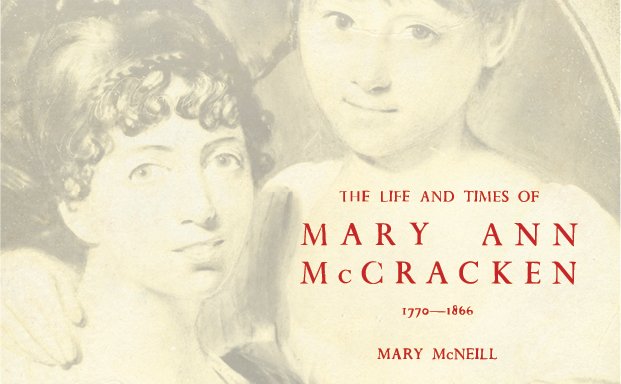The Life and Times of Mary Ann McCracken (1770 – 1866)
by Mary McNeill, (Irish Academic Press, €22.95 / £19.99)
J. Anthony Gaughan
This was first published in 1960. Ever since it has been valued by historians as an excellent biography of Mary Ann McCracken and a definitive account of the United Irishmen.
Mary Ann was born in Belfast on July 8, 1770. Her father, Captain John McCracken, was a prosperous merchant. She is best known as the sister of Henry Joy McCracken, a leader in the 1798 rebellion. Following defeat at the battle of Antrim he and some of his comrades fled to the safety of the hills. Mary Ann sought them out and supplied them with money, food and clothes.
She arranged for her brother to escape to America, but on his way through Carrickfergus to board ship he was recognised and arrested. He was arraigned before a court and sentenced to be hanged. Mary Ann accompanied him to the place of his execution. Hence the appropriate inscription on her headstone Díleas go h-éag (‘faithful unto death’).
Although Mary Ann was raised in a strictly-adhering Presbyterian family, she attended the school of David Manson, where the teaching was heavily influenced by the ideas of the French Enlightenment and the American Revolution. Thus she was imbued with the principles of Liberty, Equality and Fraternity.
Following her brother’s execution, she continued to be a supporter of the United Irishmen and assisted Thomas Russell when he visited Belfast, seeking support for the rebellion he had planned with Robert Emmet. After Emmet’s rebellion broke out prematurely and was easily crushed, Mary Ann engaged a barrister and paid the costs of the defence in Russell’s trial in 1803.
She was indefatigable in championing democratic freedoms and rights, including the rights of women. Maintaining a lively interest in politics, she was an admirer of Daniel O’Connell and a strong supporter of Catholic Emancipation.
She worked tirelessly on behalf of the women and children in the poorhouse…”
A life-long agitator for the abolition of slavery, in her late 80s, she had a stand on Belfast docks, where she distributed anti-slavery leaflets to emigrants embarking for the US. It seems that to those who suggested that she should slow down from these and other philanthropic activities she replied that “it was better to wear out than to rust out”.
From the 1790s onwards Mary Ann and her sister ran a successful business manufacturing and selling muslins. She raised her brother’s natural daughter who resided with her until her marriage.
From 1814 the sisters were members of the ladies committee of the Belfast Charitable Society concerned with the welfare of the women and children in the Belfast poorhouse. The ladies committee was re-formed as a more active body in 1827 and Mary Ann became secretary.
Thereafter she worked tirelessly on behalf of the women and children in the poorhouse. She was a lifelong supporter of equality for women, particularly through education. The famine years saw her to the fore in helping the victims and the destitute sick. She spent much of her life teaching in an undenominational school.
Mary Ann died on July 26, 1866 true to the end to her guiding principle: “Is it not the duty of every person to promote the happiness of others as much as lies in their power?”
Apart from the superb portrayal of the remarkable Mary Ann McCracken, in this study the author provides a magisterial account of the commercial, physical and political developments in Belfast during her subjects’ lifetime.



